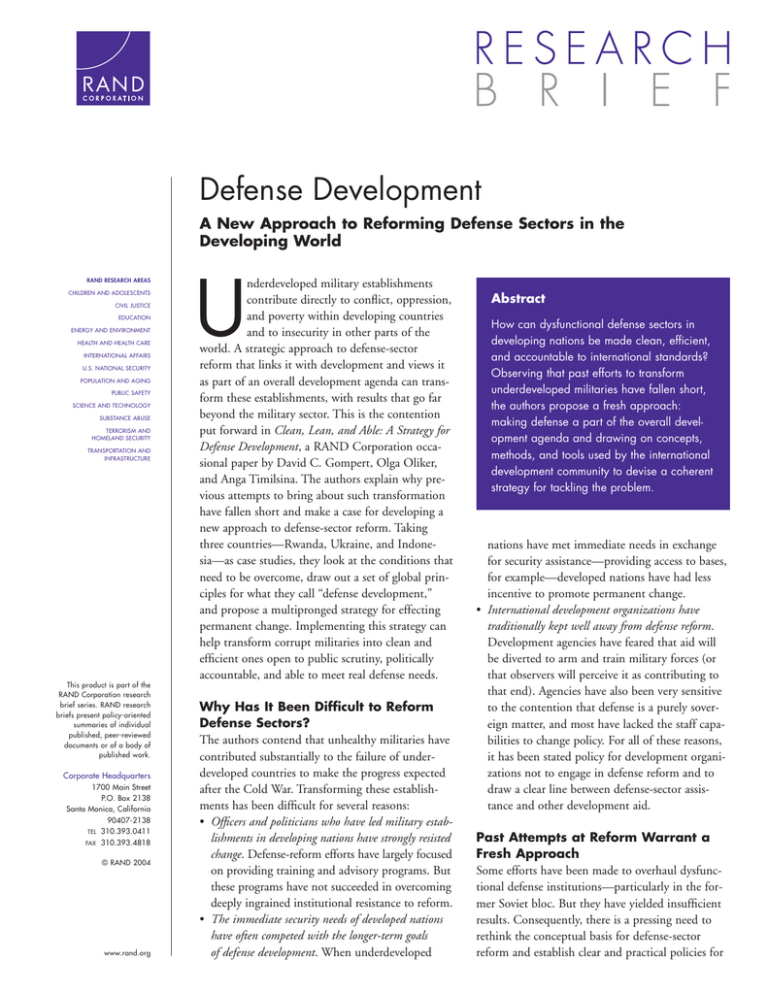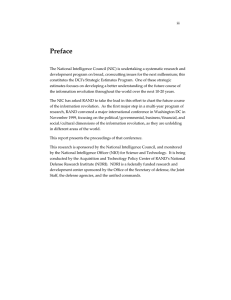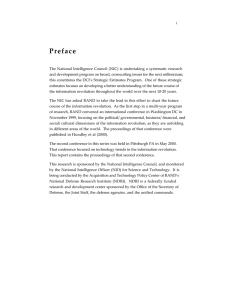U Defense Development A New Approach to Reforming Defense Sectors in the
advertisement

Defense Development A New Approach to Reforming Defense Sectors in the Developing World RAND RESEARCH AREAS CHILDREN AND ADOLESCENTS CIVIL JUSTICE EDUCATION ENERGY AND ENVIRONMENT HEALTH AND HEALTH CARE INTERNATIONAL AFFAIRS U.S. NATIONAL SECURITY POPULATION AND AGING PUBLIC SAFETY SCIENCE AND TECHNOLOGY SUBSTANCE ABUSE TERRORISM AND HOMELAND SECURITY TRANSPORTATION AND INFRASTRUCTURE This product is part of the RAND Corporation research brief series. RAND research briefs present policy-oriented summaries of individual published, peer-reviewed documents or of a body of published work. Corporate Headquarters 1700 Main Street P.O. Box 2138 Santa Monica, California 90407-2138 TEL 310.393.0411 FAX 310.393.4818 © RAND 2004 www.rand.org U nderdeveloped military establishments contribute directly to conflict, oppression, and poverty within developing countries and to insecurity in other parts of the world. A strategic approach to defense-sector reform that links it with development and views it as part of an overall development agenda can transform these establishments, with results that go far beyond the military sector. This is the contention put forward in Clean, Lean, and Able: A Strategy for Defense Development, a RAND Corporation occasional paper by David C. Gompert, Olga Oliker, and Anga Timilsina. The authors explain why previous attempts to bring about such transformation have fallen short and make a case for developing a new approach to defense-sector reform. Taking three countries—Rwanda, Ukraine, and Indonesia—as case studies, they look at the conditions that need to be overcome, draw out a set of global principles for what they call “defense development,” and propose a multipronged strategy for effecting permanent change. Implementing this strategy can help transform corrupt militaries into clean and efficient ones open to public scrutiny, politically accountable, and able to meet real defense needs. Why Has It Been Difficult to Reform Defense Sectors? The authors contend that unhealthy militaries have contributed substantially to the failure of underdeveloped countries to make the progress expected after the Cold War. Transforming these establishments has been difficult for several reasons: • Officers and politicians who have led military establishments in developing nations have strongly resisted change. Defense-reform efforts have largely focused on providing training and advisory programs. But these programs have not succeeded in overcoming deeply ingrained institutional resistance to reform. • The immediate security needs of developed nations have often competed with the longer-term goals of defense development. When underdeveloped Abstract How can dysfunctional defense sectors in developing nations be made clean, efficient, and accountable to international standards? Observing that past efforts to transform underdeveloped militaries have fallen short, the authors propose a fresh approach: making defense a part of the overall development agenda and drawing on concepts, methods, and tools used by the international development community to devise a coherent strategy for tackling the problem. nations have met immediate needs in exchange for security assistance—providing access to bases, for example—developed nations have had less incentive to promote permanent change. • International development organizations have traditionally kept well away from defense reform. Development agencies have feared that aid will be diverted to arm and train military forces (or that observers will perceive it as contributing to that end). Agencies have also been very sensitive to the contention that defense is a purely sovereign matter, and most have lacked the staff capabilities to change policy. For all of these reasons, it has been stated policy for development organizations not to engage in defense reform and to draw a clear line between defense-sector assistance and other development aid. Past Attempts at Reform Warrant a Fresh Approach Some efforts have been made to overhaul dysfunctional defense institutions—particularly in the former Soviet bloc. But they have yielded insufficient results. Consequently, there is a pressing need to rethink the conceptual basis for defense-sector reform and establish clear and practical policies for effecting permanent, sustainable change. A promising new approach is to link defense with development, viewing it like other public sectors in need of transformation and making it part of the overall development agenda. In this context, the standards, methods, and tools of international development agencies can serve as a paradigm for building a multifold strategy for reform. • National Defense Plan—an objective, transparent plan that ties force structures to capabilities, and capabilities to actual needs. A developing country would create the plan to reflect its own security requirements, with representative agencies from the international development community providing assistance and oversight. The country would be required to manage its defense according to that plan. • National Defense Development Plan—a plan that states publicly the commitments of a country’s government and armed forces to transform the defense sector. • No impermissible activities—a principle requiring that militaries adhere to a set of key “don’ts” established and accepted by donors of assistance. For example, the military should in no way be involved in either business or politics. • Conditionality—a principle requiring assistance that cannot be effective without defense reforms to be conditional on either (1) measurable progress toward military transformation or (2) a demonstrated commitment to that goal. Effective defense development depends on compelling incentives—and making aid conditional upon reform is perhaps the most powerful inducement available. What Can Be Learned from Rwanda, Indonesia, and Ukraine? To establish an empirical basis for such a strategy, the authors compared the defense sectors of three developing nations—Rwanda, Indonesia, and Ukraine. They analyzed a range of issues, from the threats each country faces, to the challenges each presents, to the importance of making progress in each. These case studies revealed a set of global principles for defense development: • The cost of defense should be transparent. • In budgeting for defense, security needs should be balanced with affordability. • Militaries should not be involved in politics. • Militaries should not be involved in business. • Defense development should be managed as long-term development, not as short-term security cooperation. • The international community should be involved. • Defense development should be tailored to fit the circumstances of individual countries. • Aid that could be affected by an unhealthy defense sector should be conditional on progress in defense-sector reform. In sum, defense development should aim to shape durable military establishments that can meet legitimate national defense needs in a transparent, lawful, and efficient manner. The Concepts and Tools of Development Make For an Innovative Strategy Political and economic development is directly linked to defense. As good governance is increasingly viewed as the foundation of both political and economic development, the four “commandments” of good governance—accountability, transparency, the rule of law, and participation—should apply equally to defense development. A strategy for defense development consists of tools and principles commonly employed in the development world to uphold these “commandments”: • Defense Development Index—an independent, impartial index, with countries ranked both by individual indicators and an overall national score, for use by international donors and the countries themselves. This tool would serve many purposes—for example, it would indicate which countries most need attention, identify priorities within countries, and provide a means to track progress. The International Development Community Faces a New Mandate—and Real Challenges The success of defense development depends on the willingness of donors, be they development or security-assistance institutions, to assume significant responsibilities—setting norms and goals, recognizing performance, and coordinating defense development with the broader development agenda. Why should they take on this challenge? First, the methods and skills used to tackle underdevelopment in other sectors hold real potential to solve the problems of defense underdevelopment. Second, because defense development goes hand in glove with economic and political development, successful reform will more broadly facilitate economic growth, good governance, and international security. Yet the task will not be easy. Developed nations will not readily prioritize defense development over more immediate security needs. Officers and politicians connected to the military will not easily accept change. Even with the best of intentions, development agencies lack expertise and credibility in the defense sector. Individual countries may be reluctant to forgo their own foreign policy and security goals to uphold international standards. But that is what it will take for defense development to work. Not just the recipients, but the donors of assistance need to be held accountable. The authors contend that the gains are worth the tradeoffs. Defense underdevelopment is potentially more harmful to international interests than any other aspect of underdevelopment. With the stakes this high, the rewards will be sizeable. This research brief describes work done for the National Defense Research Institute documented in Clean, Lean, and Able: A Strategy for Defense Development, by David C. Gompert, Olga Oliker, and Anga Timilsina, OP-101-RC (available at www.rand.org/publications/OP/OP101/), 2004, 44 pages, $15.00. It is also available from RAND Distribution Services (phone: 310-451-7002; toll free: 877-584-8642; or email: order@rand.org). The RAND Corporation is a nonprofit research organization providing objective analysis and effective solutions that address the challenges facing the public and private sectors around the world. RAND’s publications do not necessarily reflect the opinions of its research clients and sponsors. R® is a registered trademark. RAND Offices Santa Monica RB-9040-RC (2004) • Washington • Pittsburgh • New York • Doha • Berlin • Cambridge • Leiden R A N D - I N I T I AT E D R E S E A R C H CHILD POLICY CIVIL JUSTICE This PDF document was made available from www.rand.org as a public service of the RAND Corporation. EDUCATION ENERGY AND ENVIRONMENT HEALTH AND HEALTH CARE INTERNATIONAL AFFAIRS NATIONAL SECURITY POPULATION AND AGING This product is part of the RAND Corporation research brief series. RAND research briefs present policy-oriented summaries of individual published, peerreviewed documents or of a body of published work. PUBLIC SAFETY SCIENCE AND TECHNOLOGY SUBSTANCE ABUSE TERRORISM AND HOMELAND SECURITY TRANSPORTATION AND INFRASTRUCTURE The RAND Corporation is a nonprofit research organization providing objective analysis and effective solutions that address the challenges facing the public and private sectors around the world. Support RAND Browse Books & Publications Make a charitable contribution For More Information Visit RAND at www.rand.org Explore RAND-Initiated Research View document details Limited Electronic Distribution Rights This document and trademark(s) contained herein are protected by law as indicated in a notice appearing later in this work. This electronic representation of RAND intellectual property is provided for non-commercial use only. Permission is required from RAND to reproduce, or reuse in another form, any of our research documents for commercial use.


